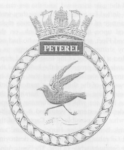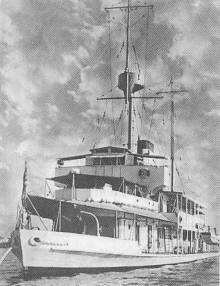- Author
- A.N. Other and NHSA Webmaster
- Subjects
- Biographies and personal histories, History - WW2
- Tags
-
- RAN Ships
- None noted.
- Publication
- December 2005 edition of the Naval Historical Review (all rights reserved)
HMS Peterel – built Whampoa 1927 (sister ships of Bird Class China River Gunboats – Tern, Gannet, Falcon, Robin, Sandpiper). Based in Hong Kong 1927-1941, but employed on patrols up the Yangtze River. 310 tons, 2 x 3″guns + MGs , speed 16 knots. Sunk in action with Japanese Coast Defence ship (ex armoured cruiser HIJMS Idzumo) at Shanghai, China, after Japanese attack on Pearl Harbour, 8 Dec 1941

(Several years ago, from a waste paper basket in the wardroom of HMAS KUTTABUL, I acquired a couple of old black and white photos of a China river gunboat. With the aid of a magnifying glass I was able to determine her name on a lifebuoy on the bridge – HMS Peterel. Subsequently I came across an obituary for a LCDR Polkinghorn Royal Navy, who had died aged over 90 in Auckland, New Zealand, which noted that he had been in command of the gunboat HMS Peterel and been sunk on the outbreak of war by the Japanese at Shanghai in 1941. This led me to some long and tedious research into this incident, culminating in discovering a unique first-hand account of the action, given by the former CO of USS Wake, a similar river gunboat, also at Shanghai at that time. Ed)
My quartermaster had just finished telling me what had happened to my ship. A Jap boarding party had come alongside during the night and taken over the ship (USS Wake) just as the radio operator tried to contact me with the news of Pearl Harbor. The still-dark night was shattered by heavy firing (these I thought were five-inch guns) There were flashes from the opposite shore as well as from a destroyer faintly visible up-river. They were firing at HMS Peterel (pronounced “petrol”), a British gunboat in command of an old friend, big, hearty 63 year old Lieutenant Polkinghorn RN. He had received news of Pearl Harbor from British Intelligence at about 0400. He had put his men at battle stations (Action Stations). At 0420 a Japanese officer, Captain Ikushima, had come aboard the Peterel and had announced that a state of war now existed between Britain and Japan and had demanded that the Peterel surrender to him. Polkinghorn had refused curtly. The Nip bowed politely and descended to his boat. The boat pulled some 300 feet away and then the Jap captain had fired a Very pistol (flare) into the air. Immediately 75 mm field guns stationed on the French Bond and on Pootung Point opposite opened fire, as did a destroyer which was moored alongside the Bund opposite the Shanghai Bank Building. Then a Japanese gunboat moored to the Customs jetty also opened up on the hapless British ship.

(Photo: Richard Francis collection)
The Peterel was swamped with this concentrated gunfire. Obviously the guns had all been trained on the Peterel and were waiting for the Very signal to start shooting. Polkinghorn, seeing that his position was helpless (he had been unable to return a single shot) told his crew to abandon ship and make for the shore. Those who were still alive got into a motor boat that had been readied and shoved off. The blackness of the night was thinning out a bit now and I could see the small boat clearly. The men were speeding frantically for shore, a shore lined with Japanese soldiers. Jets of water sprung up, framing the boat, and then a shell hit her. The boat burst into flames and capsized.
I stood there watching, unable to do anything but clench my fists and curse the Japs who were committing this deliberate murder, for murder it was. The survivors started to swim ashore. The heavy guns stopped firing and the soldiers raised their rifles. This was great sport for them. The water around the bobbing heads was alive now with small spurts. The Japs’ aim was bad. It got better as the desperate swimmers neared shore.




